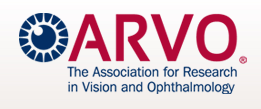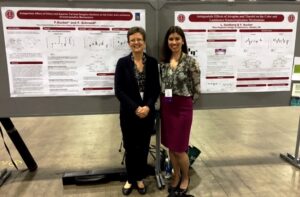The Association for Research in Vision and Ophthalmology (ARVO) is the largest eye and vision research organization in the world, including nearly 12,000 members from over 75 countries. The theme of this year’s ARVO meeting was “Powerful Connections: Vision Research and Online Networking,” and was held May 3 – May 7 in Denver, Colorado. I was fortunate to attend the conference and present my research in Dr. Frances Rucker’s lab on myopia progression. If you are considering attending ARVO 2016, it is not too early to begin planning! The theme of next year’s conference is “Research: A Vision for Hope,” and takes place May 1 – May 5 in Seattle, Washington. 
Sunday: Arrival in Denver
My ARVO experience actually began before I even left Boston’s Logan International Airport. Poster tube in one arm, travel bag in the other, I headed towards my boarding gate, where I spotted a young woman trying to stow her own poster. She turned out to be an ophthalmology resident presenting a clinical case on retinal detachments. As we boarded the plane we continued to discuss our backgrounds, discovering that we were both New Jersey natives where she attended medical school with one of my closest high school friends. Upon touchdown in Denver, we were once again greeted by the majestic Rocky Mountains that still sported snowcaps left over from the American Academy of Optometry meeting last November. As we waited for our shuttle service, we found ourselves suddenly surrounded by a moving sea of black poster cases, some having traveled from as far away as Australia. Next to us, two professors were conversing in rapid Chinese, while an Indian woman was talking to her friend about her ten-hour flight. ARVO indeed hosts the largest international research conference in the world!
For those of you planning to attend ARVO for the first time, however, fear not for getting lost in the crowd. ARVO is especially accommodating to Members-in Training (MIT) with special MIT events for students/trainees, even offering special ribbons to first-time attendees at registration. Already familiar with the Denver Convention Center, I quickly ascended the escalator to the second floor in order to attend my classmate’s poster presenting her amblyopia research. This time, the giant exhibit hall was filled to the brim with research posters on every conceivable vision-related topic. Working my way back, I encountered presentations ranging from newly-discovered genetic markers for retinitis pigmentosa to nanotechnology that promised to repair severe corneal disease. Especially exciting were the names of senior researchers stated on the posters, among them Dr. Brian Holden from the Holden Institute in Australia and Dr. Richard Stone, a major contributor to myopia research in chicks (my research area). After the poster session, my classmate and I decided to listen to a few myopia paper presentations. One in particular that stood out was the presentation of a new iPad App for Teller Acuity cards, which was cheap and portable and could be used in screenings all over the world.
Before long, it was time for the ARVO Sunday social event, “A Night at the Museums.” While enjoying cocktails and delicious appetizers we perused the Denver Art Museum and the Clyfford Still Museum exhibiting his comprehensive collection of Abstract Impressionist art. One of my favorite pieces was “Linda” by local artist John DeAndrea, a sculpture so life-like you could actually distinguish the goose bumps on the legs of the young woman asleep on the marble block. She seemed ready to open her eyes at any moment!
Monday: Poster Presentation and Award Lectures
Today was my turn to present my poster entitled “Antagonist Effects of Atropine and Timolol on the Color and Luminance Emmetropization Mechanisms,” comprising my Master in Vision Science thesis which I had successfully defended a few days prior to the conference. No sooner had I fastened the last push pin to the poster than I found myself surrounded by a group of Chinese researchers. The fact that China has performed some of the best-known clinical trials of the use of atropine to slow myopia progression may have been instrumental in their interest in any new findings involving this anti-myopia drug. I felt excited to discuss with them as well as a myriad of other scientists stopping by the result of our study that atropine with luminance flicker produced a greater hyperopic shift than atropine alone, possibly due to the release of the neuroretinal transmitter dopamine known to decrease eye length in animal models. During a quick break I spotted a student from Emory University School of Medicine presenting two boards down and decided to introduce myself. His research focused on mouse models in which they studied the effects of eliminating dopamine on the ocular components. Interestingly, they too found that, without dopamine, the eye became longer. One of my favorite parts about ARVO was the chance to meet other students who shared interest in similar research endeavors. 
Late afternoon featured two outstanding lectures, the Proctor Award Lecture “Regulation of retinal vascular growth: development, pathology and therapy” by Dr. Patricia D’Amore followed by the Weisenfeld Award Lecture “Beyond VEGF” presented by Dr. Joan Miller. VEGF is a growth factor produced by the body that is responsible for bleeding and vision loss in the eye in patients with diseases such as diabetes. In the past several years, significant funding has been allocated towards developing new “anti-VEGF” drugs that help to stop and/or even reverse this process. The evening came to a perfect conclusion with the Student/Trainee social.
Tuesday: Women in Eye and Vision (WEAVR) Luncheon
The next day I attended the Seventh Annual Women in Eye and Vision Research Luncheon hosted by the ARVO Foundation. Dr. Lilly Marks, Vice President for Health Affairs for the University of Colorado Anschutz Medical spoke on the topic of “The Art of Negotiation.” Around the room, women involved in all aspects of vision research, from industrial scientists at Pfizer Pharmaceuticals to post-docs at UCLA listened intently as Dr. Marks discussed how to handle the “challenges women in academic medicine face in negotiating for resources, positions and programs.” This presentation reinforced how dreams can be turned into realities simply by not being afraid to ask.
Final Thoughts
This article focuses on the events I had the opportunity to personally attend at ARVO 2015 and represents by no means a comprehensive account of this impressive conference. Nonetheless, I would be remiss in not mentioning the amazing ARVO/Alcon Closing Keynote Session delivered by Dr. Ian Crozier and his outstanding medical team from Emory University and the CDC. The session entitled “Ebola and the Eye: A story of Discovery and Uncertainty” delivered a message of sacrifice and hope so powerful, it moved the audience to tears. The next day, Dr. Crozier’s story was published in the New York Times, but you heard it first at ARVO 2015!

